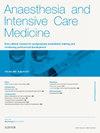Obstetric postdural puncture headache
IF 0.3
Q4 ANESTHESIOLOGY
引用次数: 0
Abstract
Postdural puncture headache (PDPH) is a complication of dural puncture resulting from cerebrospinal fluid leak associated with performance of neuraxial analgesia, neuraxial anaesthesia or a lumbar puncture. Given that neuraxial techniques are frequently employed during childbirth, PDPH is more particularly prevalent among women in the postpartum period. PDPH typically presents within 5 days post-procedure with a fronto-occipital headache, often postural in nature, accompanied by symptoms such as neck stiffness, visual and/or auditory disturbances. It affects postpartum maternal well-being, maternal–neonatal bonding and breastfeeding, and may delay hospital discharge. Untreated, PDPH has been associated with depression, chronic headache, backpain, intracranial complications such as cranial nerve palsy, subdural haematoma, cerebral venous sinus thrombosis and even maternal death. Conservative management that incorporates multi-modal analgesia and hydration are usually utilized commonly, however, an epidural blood patch remains the gold-standard for treatment of PDPH. Alternative novel treatment strategies highlighted in the literature include greater occipital and sphenopalatine nerve blocks but require more evidence to support their routine use. Timely intervention with short-term and long-term follow-up and patient education about PDPH are recommended to ensure recovery and prevent long-term sequalae of PDPH.
产科硬脊膜后穿刺头痛
硬脊膜穿刺后头痛(PDPH)是一种硬脊膜穿刺并发症,由脑脊液泄漏引起,与神经轴镇痛、神经轴麻醉或腰椎穿刺有关。鉴于在分娩期间经常采用轴向技术,产后PDPH在妇女中尤为普遍。PDPH通常在手术后5天内出现额枕头痛,通常是体位性的,伴有颈部僵硬、视觉和/或听觉障碍等症状。它会影响产后母亲的健康、母婴关系和母乳喂养,并可能延迟出院。未经治疗,PDPH与抑郁、慢性头痛、背痛、颅内并发症(如脑神经麻痹、硬膜下血肿、脑静脉窦血栓形成)甚至孕产妇死亡有关。保守治疗包括多模式的镇痛和水合作用,然而,硬膜外血贴仍然是治疗PDPH的金标准。文献中强调的其他新治疗策略包括枕骨和蝶腭神经阻滞,但需要更多的证据来支持其常规使用。建议及时干预,进行短期和长期随访,并对患者进行教育,以确保患者康复,防止长期后遗症。
本文章由计算机程序翻译,如有差异,请以英文原文为准。
求助全文
约1分钟内获得全文
求助全文
来源期刊

Anaesthesia and Intensive Care Medicine
ANESTHESIOLOGY-
CiteScore
0.50
自引率
0.00%
发文量
152
期刊介绍:
Anaesthesia and Intensive Care Medicine, an invaluable source of up-to-date information, with the curriculum of both the Primary and Final FRCA examinations covered over a three-year cycle. Published monthly this ever-updating text book will be an invaluable source for both trainee and experienced anaesthetists. The enthusiastic editorial board, under the guidance of two eminent and experienced series editors, ensures Anaesthesia and Intensive Care Medicine covers all the key topics in a comprehensive and authoritative manner. Articles now include learning objectives and eash issue features MCQs, facilitating self-directed learning and enabling readers at all levels to test their knowledge. Each issue is divided between basic scientific and clinical sections. The basic science articles include anatomy, physiology, pharmacology, physics and clinical measurement, while the clinical sections cover anaesthetic agents and techniques, assessment and perioperative management. Further sections cover audit, trials, statistics, ethical and legal medicine, and the management of acute and chronic pain.
 求助内容:
求助内容: 应助结果提醒方式:
应助结果提醒方式:


